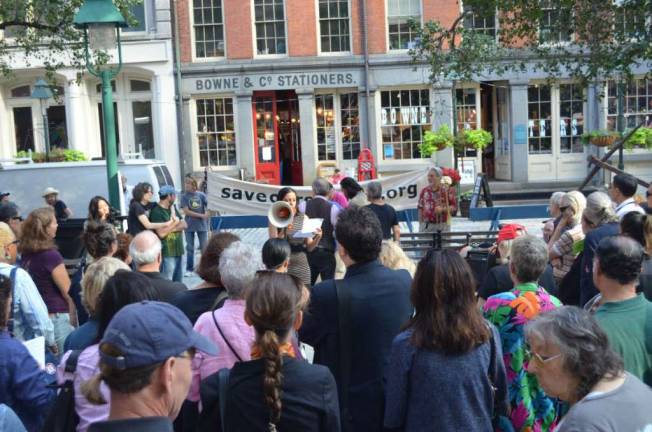Save Our Seaport Rally

Residents came out to voice their disaproval of a plan to develop the historic area
On Saturday, October 5th, over 150 downtown residents and politicians rallied together to help "Save the Seaport" and speak out in favor of maintaining the historic nature of the Seaport and its museum.
The rally was prompted by the New York City Economic Development Corporation's recent refusal to comply with a local reporter's request to disclose their negotiations with the Howard Hughes Corporation regarding their plans for the Seaport's neighboring New Market Building and the Tin Building. Earlier this year, the Howard Hughes Corporation revealed that they intend to convert the area surrounding the South Street Seaport into high-rise hotels, condos, and upscale retail stores, which residents fear will compromise its historic character.
"We don't want a huge mall-like presence to be the result of a Howard Hughes takeover," said Save Our Seaport Spokesperson David Sheldon after the rally. "It can still promote economic development and serve as a unique public space without being turned into high-rise condos and expensive retail stores."
Saturday's speakers included Gale Brewer, New York City Council Member and Democratic Nominee for Manhattan Borough President, Peter Stanford, Founding President of the South Street Seaport Museum, Roland Lewis, President and CEO of the Metropolitan Waterfront Alliance, Jenifer Rajkumar, Democratic District Leader, and Paul Greenberg, journalist and author of the James Beard Award-winning Four Fish: The Future of the Last Wild Food.
All spoke in opposition to the city's handover of the South Street Seaport to Howard Hughes, and expressed hope that the incoming administration would slow the process, giving the community an opportunity to have a say in the Seaport's future. Several speakers pointed out the Seaport's national significance as birthplace of the Port of New York and as the city's original Market district.
Rajkumar repeatedly-and disparagingly-referred to Howard Hughes as "the Texas developer," and drew applause with her vision for a public market that would rival those of other cities, providing locals and tourists with a unique destination, and emerging, food-related entrepreneurs with a place to grow their businesses
There has, already, existed the beginning of a food market like that: the New Amsterdam Market, a favorite of tourists, residents, and other New Yorkers, which has lived under the FDR Drive, near the Tin Market Building and New Market Building, since 2005.
Its founder and president, Robert LaValva, said that the vendors, farmers, and other community members are dedicated to bringing the market, and have an "intense commitment to persevere against the many obstacles that invariably oppose a business whose mission is to heal rather than destroy."
"I have heard this confidence time and again from aspiring market vendors, chefs, and other small businesses," he said. "It is a confidence totally unlike the slick and boastful arrogance of cheaters who get ahead with backroom deals and by hiding their intentions from the public."
Gale Brewer stepped in to praise the Seaport's history and uniqueness, pointing to her efforts to slow the encroachment of banks and other big-box storefronts on the Upper West Side, which she currently represents. She expressed hope that instead of turning the Seaport into "just another cookie-cutter mall," the City and community could find more creative solutions.
"Just as with Seward Park, a public planning process to determine the future of the Seaport is imperative," she said. "It's a public site. Such a planning process would ensure community needs and desires are met."